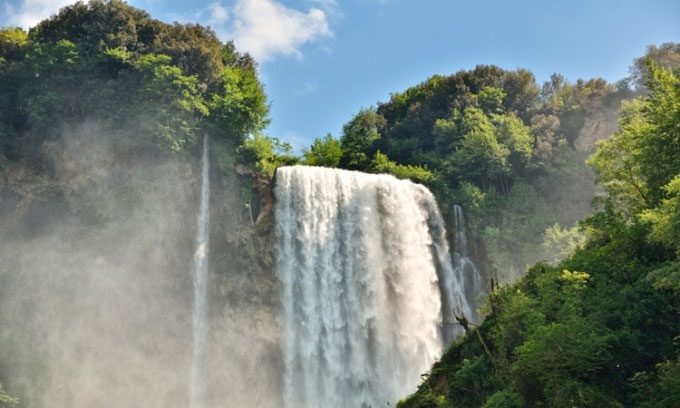The Marmore Waterfall, standing at 165 meters, was created when ancient Romans diverted the Velino River 2,200 years ago.
The stunning three-tiered waterfall, known as Marmore Falls, is located approximately 8 kilometers east of the city of Terni in the Umbria region of Italy. This waterfall was once a popular destination for wealthy young English aristocrats in the 17th and 18th centuries, who traveled to England and Italy to explore the origins of Western civilization. The allure of Marmore Falls lies not only in its grandeur but also in the fact that it is a result of human intervention in nature, according to Amusing Planet.

Marmore Falls in Italy. (Photo: MilaCroft)
2,200 years ago, there were no waterfalls in the area. The Velino River, where the waterfall is located, flowed entirely differently, emptying into a swamp in the Rieti Valley. The stagnant water in the swamp was thought to be unhealthy and was blamed for various diseases affecting the local population. Consequently, the Roman official Manius Curius Dentatus ordered the construction of a canal known as the Curiano Channel in 271 BC to drain the swamp and direct the water into the natural cliffs at Marmore, thus creating the waterfall. From there, the water flowed down to the Nera River below.
However, the solution did not work as intended. The Rieti Valley continued to experience flooding. When the Velino River rose, it also flooded the Terni Valley, where the river changed course. The artificial canal and the flooding then became a long-standing source of conflict between the residents of Terni and the Rieti Valley. The people of Terni wanted to close the canal, while those living in the Rieti Valley sought to increase the flow of the waterfall to accommodate excess water. The issue between the two cities became so tense that the Roman Senate had to intervene in 54 BC, but they were unable to reach a consensus, and the problem persisted for centuries.
After the fall of the Roman Empire, invasions and the development of feudalism caused many territories and rural areas to be neglected. Due to a lack of maintenance, the bottom of the Curiano Channel accumulated mud, and the Rieti Valley was flooded once again. It was not until the 15th century that Pope Gregory XII ordered the construction of a new canal to restore the original flow. Improvements were made by Pope Paul III in the mid-16th century, who installed a regulating valve to control the flow. The final adjustments that gave the waterfall its current appearance were carried out by architect Andrea Vici under the direction of Pope Pius VI at the end of the 18th century.
Andrea Vici managed to address most of the flooding issues, keeping the waterfall intact for the past 200 years. However, a hydroelectric plant on the Velino River now causes the flow of the waterfall to be restricted or reduced depending on the times when the plant releases water. Water is released twice a day, from 12 PM to 1 PM and from 4 PM to 5 PM. The Marmore Falls have a total height of 165 meters, making it the tallest man-made waterfall in the world. Among its three tiers, the highest tier reaches 83 meters.


















































